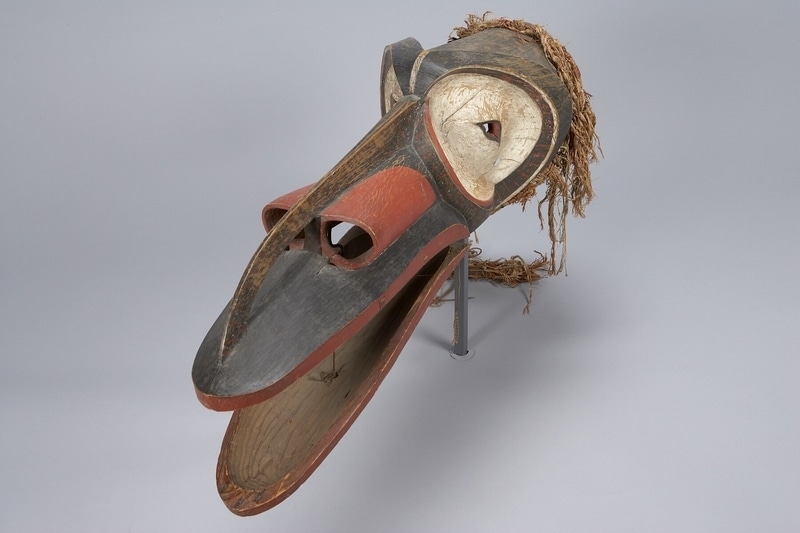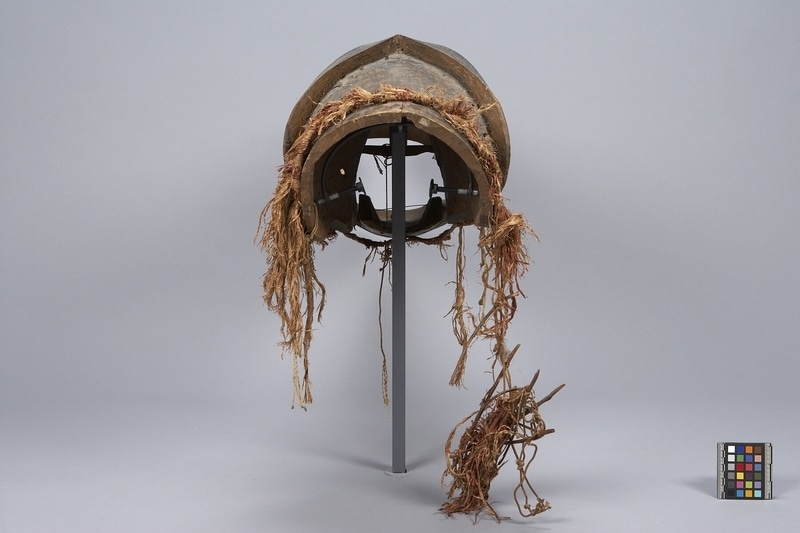Mask Item Number: A1806 from the MOA: University of British Columbia



Description
Carved wooden, crooked beak mask. The beak has long, exaggerated, protruding red nostrils with two large circular openings in the front. Running from the brow is a large, protruding, central black, rectangular shaped frill that projects outwards then curves downwards to the top of the beak. On the top edge of the head is a smaller, rounded, black frill that tapers into the top of the head. The mouth is red, flat and protruding. The underside of the beak is black; beak is hinged with a thin piece of metal wire. The eyes are small and outlined in black and red, surrounded by a large white, sunken, ovoid-like shape; the brow is black with red vertical stripes. Back of mask is slightly cylindrical in shape; around the top, side and bottom edges are twisted pieces of cedar. The inside of the mask is hollow with the exception of pieces of fibre twine to articulate the beak; bundles of small branches with cedar strips and a piece of eagle down. The mask is painted black, white and red with Northwest Coast stylized forms.
History Of Use
The Hamat’sa dance complex, to which this mask belongs, is understood to have originated in ceremonials of the Wuikinuxv people, and became part of Heiltsuk and Nuxalk practices through intermarriage. The Kwagu’l of Fort Rupert are said to have originally acquired this and related winter-ceremonial privileges in the early 1800s through warfare with the Heiltsuk, while other Kwakwaka’wakw nations and families have their own histories of how they received the right to perform this important dance. Today, the Hamat’sa ceremony is practiced among all the nations of the central coast.
Narrative
This Lxulhla, or crooked-beak-style mask, represents one of the supernatural man-eating birds, the assistants of the cannibal being whose spirit possesses the Hamat’sa initiate. Some families have inherited the right to use masks representing this being, distinguished by its “crooked beak”: a broad, rounded bill with a curved projection on top. In contrast to the more prevalent Kwakwaka’wakw style of Galukwiwe’ (crooked-beak headdress) of the 20th century, featuring an often elaborately painted arch above the beak, this Nuxalk Lxulhla has a more archaic appearance and shares a similar eye shape eye and elongated nostril form with other historical Nuxalk masks. It was made to fit over the dancer’s forehead, with a cedar-bark fringe concealing the face and shoulders. The dancer would clap the beak loudly at specific moments in the dance.
Item History
- Made in British Columbia, Canada before 1948
- Owned by F. G. Sherbourne
- Owned by Mrs. F. G. Sherbourne before 1948
- Received from Mrs. F. G. Sherbourne (Donor) during 1948
What
- Name
- Mask
- Identification Number
- A1806
- Type of Item
- mask
- Material
- red cedar wood, cedar bark, paint, fibre, metal and eagle down feather
- Manufacturing Technique
- carved, pegged, bored and painted
- Overall
- height 29.2 cm, width 32.3 cm, depth 103.8 cm
Who
- Culture
- Nuxalk
- Previous Owner
- F. G. Sherbourne and Mrs. F. G. Sherbourne
- Received from
- Mrs. F. G. Sherbourne (Donor)
Where
- Holding Institution
- MOA: University of British Columbia
- Made in
- British Columbia, Canada
When
- Creation Date
- before 1948
- Ownership Date
- before 1948
- Acquisition Date
- during 1948
Other
- Condition
- fair
- Accession Number
- 2157/0001